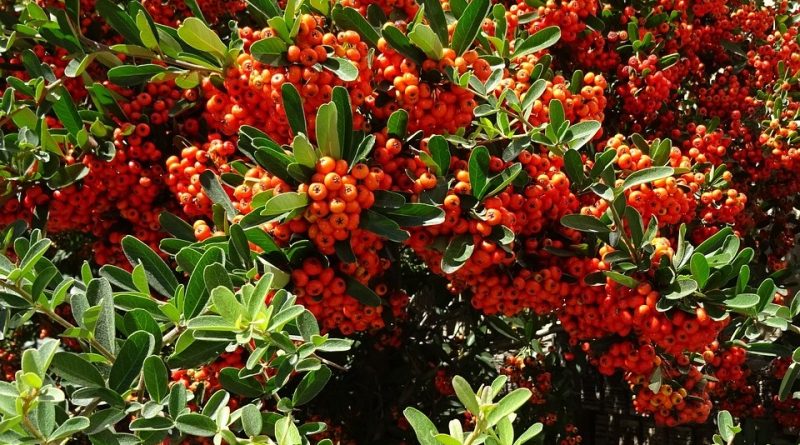Pyracantha coccinea
Pyracantha coccinea
The Scarlet Firethorn (Pyracantha coccinea M. Roem.) Is a shrub species belonging to the Rosaceae family.
Systematics –
From the systematic point of view it belongs to the Eukaryota Domain, United Plantae, Magnoliophyta Division, Magnoliopsida Class, Subclass Rosidae, Rosales Order, Rosaceae Family and therefore to the Genus Pyracantha and to the P. coccinea Species.
Etymology –
The term Pyracantha comes from the Greek πῦρ, πῠρός pyr, pyrós fire and from ἄκανθα ácantha spina: with red or burning spines like fire. The specific epithet coccinea comes from scarlet cóccinus: scarlet.
Geographical Distribution and Habitat –
The Scarlet Firethorn is a species native to south-eastern Europe and Asia Minor and used and distributed for ornamental purposes and to form impenetrable hedges thanks to the presence of long thorns. In Italy it is also found in the spontaneous state.
Description –
Pyracantha coccinea is a shrubby species that becomes deciduous in climates, with spiny branches.
The leaves are simple, small, between 2 and 6 cm in size, elongated, with a roundish tip, emerald green in color, with entire or slightly serrated edges.
The flowers are hermaphrodite, star-shaped, white or pink, with five petals, united in corymbs.
The anthesis is in the period between May and June.
The fruits are small berries of 0.5 cm in diameter of variable color, depending on the variety, red, yellow or orange.
Cultivation –
The Scarlet Firethorn is a very versatile plant in cultivation and for the construction of hedges, widely used in Italian gardens. It does not have particular climatic requirements, it does not fear nor frost, it can withstand up to minus 15 ° C, nor the summer heat.
The presence of thorny branches makes it suitable for intrusion barriers; the candida bloom in May (not really scented) illuminates the foliage and the berries, in autumn, of red, orange or yellow color, give color to the gardens and constitute an excellent food for the birds.
For cultivation it is advisable to choose areas in full sun, to obtain abundant blooms even if it grows well even in the shade.
This plant has a wide thermal tolerance, from the shores of the sea to the high mountains. Resists on any type of soil, even dry, stony or heavy, as long as there is good drainage. After the first year of life, it is no longer necessary to water it.
In any case, a dose of organic fertilizer is recommended at the plant.
For the pruning technique, remember that if it is pruned in April, the shed will not flower and, consequently, it will not produce berries. To obtain them, the cutting intervention must be postponed immediately after flowering, at the end of May, trying to preserve the twigs that have bloomed.
Plants left in their natural state do not require pruning; if instead they are used to form hedges, after having planted them at 50-70 cm one from the other, to maintain the shape and size, it is necessary to prune them regularly 2 or 3 times a year.
In general it is cultivated in shrub form and reaches 2-4 m.
Uses and Traditions –
The Pyracantha coccinea is an ornamental plant widely used for hedges; it bears pruning well, it is a hardy and rustic plant. Moreover with small spines it can be used as a defensive plant and impenetrable on the boundaries of the plots.
Due to the dense and thorny foliage it is in fact used to form impenetrable hedges, for defensive and ornamental purposes at the same time, due to its pleasant appearance. Moreover, given its ability to withstand air pollution, it is particularly suitable for use in city parks. Numerous varieties of different colors and sizes have been produced.
This plant is much visited by bees that gather nectar and pollen.
Preparation Mode –
Scarlet Firethorn can be used in the warehouse, which look like small apples, bright red or bluish black and which, even if they are edible, as bitter and astringent, it is preferable to consume them after cooking; for this reason they are often used to prepare jams.
Guido Bissanti
Sources
– Acta Plantarum – Flora of the Italian Regions.
– Wikipedia, the free encyclopedia.
– Treben M., 2000. Health from the Pharmacy of the Lord, Advice and experiences with medicinal herbs, Ennsthaler Editore
– Pignatti S., 1982. Flora of Italy, Edagricole, Bologna.
– Conti F., Abbate G., Alessandrini A., Blasi C. (edited by), 2005. An annotated checklist of the Italian vascular flora, Palombi Editore.
Attention: Pharmaceutical applications and food uses are indicated for informational purposes only, do not in any way represent a medical prescription; therefore no responsibility is assumed for their use for curative, aesthetic or food purposes.


